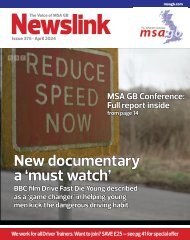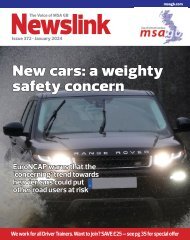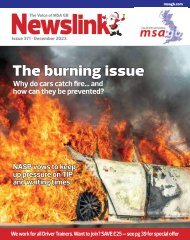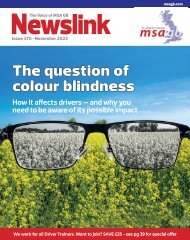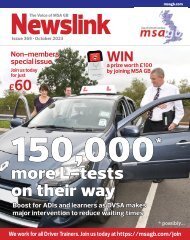Newslink November 2020
Motor Schools Association of Great Britain membership magazine. Information and news on driver training and testing and road safety issues
Motor Schools Association of Great Britain membership magazine. Information and news on driver training and testing and road safety issues
- No tags were found...
You also want an ePaper? Increase the reach of your titles
YUMPU automatically turns print PDFs into web optimized ePapers that Google loves.
For all the latest news, see www.msagb.com<br />
one of the bulbs for the first time. It had<br />
‘made in France’ stamped on it. The<br />
replacement is from China; I wonder if<br />
it’ll last another 19 years?<br />
It is common sense but if common<br />
sense were so common, people wouldn’t<br />
keep making these mistakes.<br />
Canada made automatic daytime<br />
running lights mandatory on new<br />
vehicles built after December 1, 1989.<br />
Studies had shown that front lights<br />
reduced collisions because they made<br />
oncoming vehicles more easily seen –<br />
from as far as a kilometre away – by<br />
drivers, pedestrians and cyclists.<br />
But those studies also found that<br />
daytime rear and side lights did not<br />
make a significant difference to the<br />
number of crashes, mainly because they<br />
are not bright enough to be seen from a<br />
distance during the day.<br />
Transport Canada says: “Even if those<br />
daytime tail lights were brighter, cars<br />
travelling at normal speeds can see<br />
vehicles in front of them in plenty of time<br />
– from about 150 metres away – to<br />
avoid a rear end collision during the<br />
day.”<br />
Volvo is an exception. If lights are set<br />
to auto, then the tail lights will come on<br />
with the front DRL. Also, when in auto<br />
mode, the car will switch off the DRLs<br />
when it gets dark, and switch on dip/<br />
main beam subject to any light input.<br />
For 30 years it has been recommended<br />
that drivers turn on low beams during<br />
the day, even if they have DRLs.<br />
While front DRLs make cars more<br />
visible from the front and reduce<br />
head-on collisions, there is a dark side,<br />
because those lights are only in front,<br />
you do not get any added visibility from<br />
the rear.<br />
With 33 per cent of crashes being<br />
rear-enders, having your taillights on<br />
makes you more visible to the other<br />
vehicles around you, especially as it<br />
starts to get dark.<br />
The idea that tail lights ‘desensitise’<br />
drivers to brake lights is indeed “an old<br />
wives’ tale.” - Fleet Trainer<br />
Editor’s note – Sweden changed from<br />
driving on the left to the right on 3<br />
September 1967. Drivers were required<br />
to use lights dipped headlights during<br />
the day. This was to remind pedestrians<br />
that vehicles will be initially approaching<br />
from the left, hence no need show lights<br />
at rear.<br />
Domestic car manufacturers Volvo and<br />
Saab began to build this automatic<br />
system into their vehicles. This was later<br />
adopted in a wider market.<br />
‘First-of-its-kind’ assisted driver<br />
grading system launched<br />
A new grading system has been<br />
launched to help drivers better<br />
understand autonomous emergency<br />
driving and other assisted driving<br />
features on modern cars.<br />
The ‘first-of-its-kind’ system has been<br />
launched by Thatcham Research and<br />
Euro NCAP in response to the<br />
“dangerous misconception” that<br />
motorists can purchase a self-driving<br />
car today.<br />
A grading of very good, good,<br />
moderate or entry is awarded to cars<br />
– depending on their performance<br />
during a number of tests.<br />
Cars are marked on three criteria:<br />
vehicle assistance (how effective the<br />
systems are), driver engagement<br />
(whether the car assesses if the driver<br />
is still in control of the vehicle) and<br />
safety back-up (whether or not the car<br />
protects the driver in the event of an<br />
emergency).<br />
One system that’s assessed is<br />
Highway Assist. The feature uses<br />
Adaptive Cruise Control (ACC) and<br />
Lane Centering (LC) technology to help<br />
drivers maintain a steady speed and<br />
keep a safe distance from other cars<br />
when driving on a motorway.<br />
Thatcham Research warns there is<br />
“significant potential for car makers to<br />
overstate the capability of their current<br />
assisted driving technology and for<br />
motorists to misuse it.”<br />
Matthew Avery, Thatcham’s director<br />
of research, said: “The systems that are<br />
currently allowed on our roads are<br />
Driver lane assist is one of systems graded in the new test<br />
there to assist the driver – but do not<br />
replace them. Unfortunately, there are<br />
motorists who believe that they can<br />
purchase a self-driving car today.<br />
“This is a dangerous misconception<br />
that sees too much control handed to<br />
vehicles that are not ready to cope with<br />
all situations.”<br />
After the first set of assessments,<br />
three cars were awarded a ‘very good’<br />
grading – including the Mercedes GLE,<br />
which topped the scoring with 174.<br />
The BMW 3 Series (172) and Audi Q8<br />
(162) were also given the top ranking.<br />
Meanwhile, while the Tesla Model 3<br />
was the best for vehicle assistance and<br />
safety back-up, the all-electric car lost<br />
points for overselling its ‘Autopilot’<br />
system, which was found to discourage<br />
drivers from engaging when behind the<br />
wheel.<br />
This saw it awarded a score of 131<br />
and a grading of ‘moderate’.<br />
Mr Avery added: “The first batch of<br />
results show some car makers have<br />
developed robust assisted driving<br />
systems and that’s good to see. But<br />
there are also significant gaps in<br />
capability on other vehicles.”<br />
“Clarity is therefore required to make<br />
sure drivers understand the capability<br />
and performance of current assisted<br />
systems.<br />
“It’s crucial today’s technology is<br />
adopted safely before we take the next<br />
step on the road to automation. There<br />
are safety and insurance implications<br />
that must be considered seriously.”<br />
www.msagb.com<br />
41





